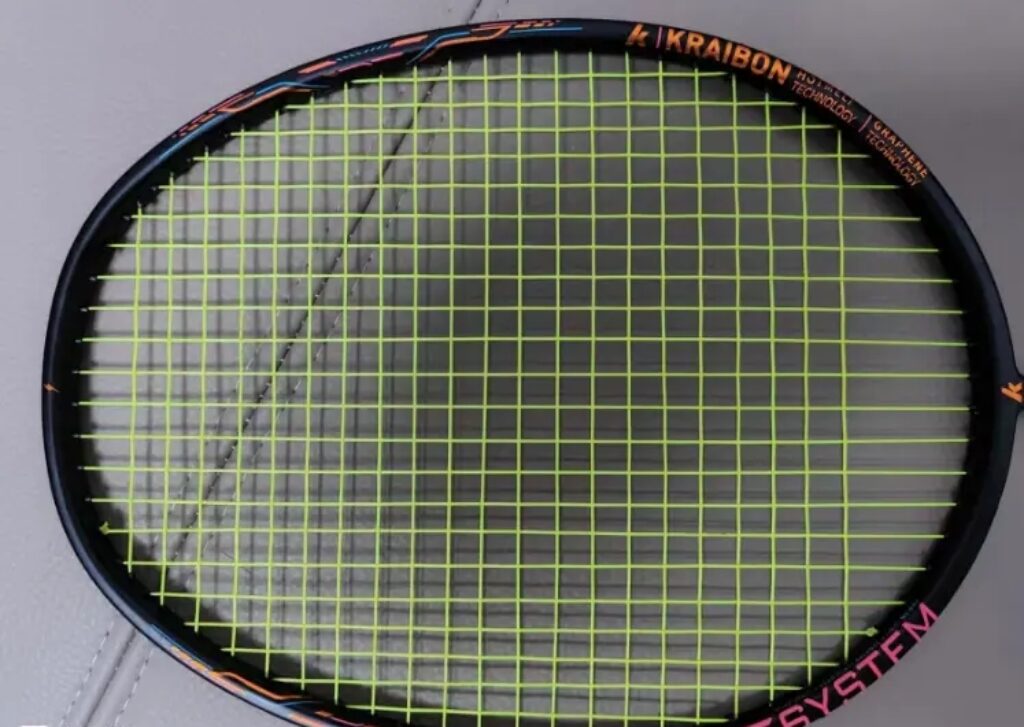Everything can be copied or borrowed. However, for brands with their own production lines, even if they are targeted by others, they can only have their appearance or fonts copied at most, since the craftsmanship, materials, and channels are still in their hands.
However, among brands with their own production lines, copying each other is a pretty mean act. As an onlooker, I naturally enjoy the drama. Kawasaki’s new Thunder F10 is something else.

Parameters: 4UG5, with a base, total weight 95.1g, balance point 299mm, shaft length 213mm, medium-high stiffness, box frame, 76-hole string bed, 8-4 string groove, warranty up to 30 lbs, strung at 26-28 lbs BS710.
This appearance—with a matte black carbon base, ultra-thin shaft, and gold lettering at 4 and 8 o’clock—what more can I say? Just look at it; the paint quality is still pretty good. Aside from potential controversies over the appearance, I want to share a hearsay story. It seems that Kawasaki was the first to propose the “Thunder” series name, with the F8 as the series’ first installment, but the English name was “thunderbolt,” which is actually not the same. However, as everyone knows, Kawasaki’s brand appeal can’t compete with the big names, and the Chinese name for this series was taken by the red factory, which became quite popular. Isn’t there a bit of an NTR vibe here? The “you do the first of the month, I’ll do the fifteenth” storyline resembles a yellow-haired character invading someone else’s territory, doesn’t it?

Wow, the moment I got my hands on the F10, it ignited my desire to attack; I hadn’t even taken it out for a proper match yet. Kawasaki also has a new offensive model, the Spider-Man 8100 Pro, this season, but the F10’s head-heavy feel is certainly not inferior to the former. I believe its air swing weight is among the top in the 4U category, which is still within my adaptable range. On the day I tried it, I didn’t have time to adjust to the F10; I just went straight into a match with it.
To be honest, this isn’t a peculiar or unfriendly racket. Aside from a slightly high swing weight, its good power transfer, large sweet spot distribution, and above-average elasticity for its specs allow players with decent strength to effectively utilize it. The direct feedback during hits gives the F10 a satisfying feeling, making it a piece of equipment that motivates players to keep using it. Let’s not say things like “this racket looks unresponsive and unsuitable for flat shots”—it’s clearly not made for that, but that doesn’t mean it’s not excellent.

I still remember the feel of the Thunder 80, and the F10 is definitely not its follower; they feel different in play. The former is very balanced among offensive rackets, while the latter delivers the classic feel of a true offensive racket. The box frame’s inherent resistance to twisting gives the F10 excellent shot direction. Not only for downward strikes but also for pushes and high clears that require some control, the F10 can deliver the trajectory I envision, landing precisely where I want. With the head weight and shaft elasticity, the F10’s feedback feels quite “explosive”—powerful, speedy, and satisfying. This racket is clearly more aggressive than the Thunder 80.
The racket’s control during net play is also outstanding. I personally enjoy using slightly head-heavy rackets for net shots or lifts, as it stabilizes the feel. When I reach a high point in the backcourt, a normal swing can bring the shuttle to the opponent’s net with precision. Sometimes, during a hasty response to an opponent’s heavy smash, the proper unloading feel can turn the tide from defense to offense.

Regarding the F10’s offensive performance, I believe it’s the most “explosive” Kawasaki racket I’ve used this year—very intense. The ultra-thin shaft’s energy release is somewhat beyond my expectations. When I focus my energy, the F10 performs very solidly, with efficient power transmission. Even with its obvious head-heavy nature, which allows users with less strength to strike solid downward shots, reckless power can make the offensive effect truly intimidating. This intimidation stems from the combination of sound, speed, and feedback—an exceptional experience. It’s not one of those clunky rackets that sacrifices continuity for a powerful smash; the shaft’s quick recovery ensures that I can maintain consistent backcourt output during testing. Notably, despite its slightly higher stiffness, it still retains a certain resilience during heavy smashes.
On the other hand, the passive performance of this new racket really tests the player’s skills.

I initially speculated that it wouldn’t be suitable for fast-paced flat shots, and my actual experience confirmed this. During doubles rotation in the front court, I often had to step back half a step more than usual to avoid being caught by the opponent’s flat shots. Simply put, the Thunder F10 might show a sluggish side in switching grip positions and maintaining a fluid stroke. However, if we really had to rank it, the F10’s decisive shot delivery and quicker shaft recovery prevent it from being the bottom performer in fast exchanges, at least with the Spider-Man to back it up. Moreover, its segmented fish-mouth cone cap allows for some flexibility in thumb positioning during backhand grips.
It’s clear that this 4.5-star offering is more suited for intermediate players; the F10 fits well in situations where an 88D can be used, highlighting a thoroughly enjoyable offensive experience. However, I do wonder about the timing of this high-quality new release, coming in direct competition with the Spider-Man, which seems a bit unwise.


Leave a Reply